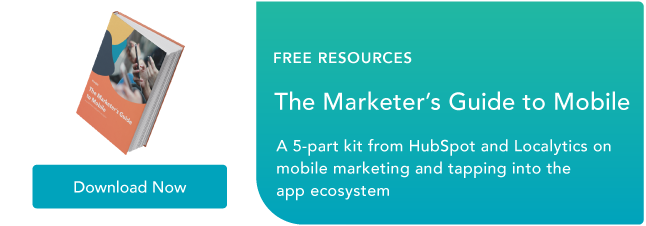Smartphones have become an extension of ourselves. Today, more and more people around the world are relying on mobile phones for info, fun, and to stay connected with one another.
This means that people are now much more inclined to grab their phones and browse the internet rather than engage with traditional media. In fact, data shows that about 55% of traffic on websites comes from mobile devices.
Therefore, the idea that “mobile could surpass fixed internet access” is no longer a marketing gimmick but a reality. That’s why mobile marketing campaigns are so effective. In this article, we’ll explore some effective mobile marketing campaigns that can inspire your success.
What are mobile marketing campaigns?
Mobile marketing campaigns are strategic efforts to reach and engage with a target audience through mobile devices like smartphones and tablets.
It involves creating and delivering content, messages, or experiences specifically designed for mobile users. Think of it as a way to communicate with people wherever they are, using the device they carry around most often.
These campaigns come in different shapes: text messages, mobile-friendly websites, mobile apps, display mobile ads, and social media content that looks great on mobile screens.
The ultimate aim is to catch the eye of mobile users, providing them with pertinent information, irresistible offers, or engaging experiences. Encourage them to take action, whether it’s making a purchase, signing up for your offerings, or spreading the content to their networks.
The core of mobile marketing campaigns is seizing the opportunities presented by mobile devices to connect with your customers in a seamless and impactful manner.
Types of Mobile Marketing Campaigns
Here are some types of campaigns you can run in the context of mobile marketing.
Transactional Campaigns
These campaigns focus on delivering personalized messages to the audience based on their previous interactions with your mobile app or website. This could include order confirmations, shipping notifications, or account updates. Enhancing the transactional experience adds a touch of professionalism and builds trust.
Location-Based Campaigns
Leveraging geolocation data, you can craft campaigns that target users based on their physical location. Offering location-specific deals, event notifications, or recommendations creates a sense of relevance and fosters engagement.
Promotional Campaigns
These campaigns are all about showcasing your products or services in a compelling manner. Use mobile-friendly visuals and concise messaging to highlight special offers, discounts, or new arrivals. Engage users and entice them to explore what you have to offer.
Dynamic Content Campaigns
Dynamic content is your secret weapon for personalization. Craft campaigns that dynamically adapt to individual user preferences, behavior, and demographics. This way, your content resonates deeply, driving better engagement and conversions.
Onboarding Campaigns
Welcoming new users is crucial to their long-term engagement. Develop onboarding campaigns that guide users through the essential features of your app, ensuring they have a smooth and enjoyable experience right from the start.
Opt-in Priming Campaigns
Building a strong subscriber base requires finesse. Create campaigns that educate users about the benefits of opting in for notifications or updates. Explain how they stand to gain value from staying connected with your brand.
Best Mobile Marketing Campaign Examples
Here are some brands that won the mobile marketing game:
1. Burger King’s “Burn That Ad”
Burger King’s Burn That Ad campaign was a big hit. People who got the Burger King app could use their phones to burn ads from other burger places. It was fun, and they got a free burger from Burger King for doing it. The campaign worked well because it had everything people liked.
Also, the campaign had a clear message: Stick with Burger King for burgers, and don’t bother with others. This mix of fun, free food, and a strong message made the campaign really popular.

What we like: We love Burger King’s Burn That Ad campaign because it resonates by blending interaction, reward, and brand message. The free burger offer entices participation and aligns with our human inclination for incentives. This combination of engagement, benefit, and clear branding creates a compelling and memorable experience.
2. Nivea Sun Kids Campaign
Nivea’s Sun Range mobile marketing campaign stood out as an innovative success, blending print and mobile strategies. Parents could connect a bracelet from print ads to a Nivea protege app, so they could receive an alert if their kids wandered off the beach.

The campaign is commendable for its seamless fusion of offline and online strategies. Nivea effectively engaged their audience using print and mobile elements, which helps enhance brand loyalty and ongoing user engagement.
What we like: This campaign focuses on assistance over direct product promotion, creating a strong customer bond that will result in long-term loyalty.
3. IKEA Mobile App
IKEA, the renowned furniture giant, executed a highly successful mobile marketing campaign that earned it recognition and the distinction of having the most downloaded app.
They used Augmented Reality (AR) to develop a mobile app that interacts with customers to address a significant challenge in furniture shopping. With the app, IKEA customers can visualize its products within their living spaces before purchasing.

Interestingly, this approach has yielded compelling results. Customers now spend an average of five extra minutes on the app compared to browsing the traditional IKEA catalog.
What we like: We love this approach because the combination of practicality and entertainment has not only captured users' attention but also significantly increased their engagement.
4. Sephora’s Location-Based Messaging
Sephora employs location-based mobile marketing to enhance its omnichannel strategy and boost customer visits to its physical stores. When customers approach a certain distance from their stores, they receive a mobile app notification offering discounts or incentives to visit. The notification is concise and appealing, emphasizing the advantages of in-store shopping.

Sephora takes it a step further with beacon technology in their app, which detects when a customer enters the store and sends personalized notifications, including store maps, to improve the shopping experience and entice customers to return.
What we like: Sephora’s strategy showcases effective communication, customer-centricity, and innovation in using mobile technology to enhance the overall shopping journey.
5. Netflix’s App Push Notifications
Netflix excels at sending personalized push notifications to keep users engaged. These notifications are based on user behavior, reminding them to continue watching where they left off or informing them about new content.

This smart strategy boosts app retention rates significantly, sometimes up to 10 times more effective than normal. What makes these push notifications engaging? Personalization, using user data to send relevant content, and crafting visually appealing messages with media and emojis.
What we like: This campaign is appealing because it aligns with their emphasis on personalized and data-driven marketing.
6. AliExpress’ Cut the Price
AliExpress introduced an engaging app marketing campaign where customers could invite friends using special links to lower the price of a specific product. This required friends to click on a specific button within the app.
Customers had 24 hours to invite the necessary number of friends, and once achieved, the product’s price would drop to as low as 0.1 USD, allowing the purchase. The campaign went viral, attracting a significant number of new users to AliExpress.

What we like: The use of referral-based discounts encourages social sharing and word-of-mouth promotion. Additionally, the integration of mobile push notifications and loyalty programs demonstrates a multi-faceted approach to engaging users and providing value-driven interactions.
7. LG’s Ticket Hunter
Mindshare UK, a marketing agency, used a mobile game on X (formerly Twitter) called LG Ticket Hunter to help LG target a young female audience for promoting L-series handsets. Players searched for VIP tickets for a One Direction concert hidden in 25 locations. They tweeted #lgtickethunter to reveal map locations gradually.

What we like: The campaign is a great example of leveraging social media. It generated excitement, with 58,000 users sharing posts using #lgtickethunter, resulting in a 28% boost in sales.
8. Adidas WhatsApp Business
Adidas used WhatsApp Business to create a cool campaign called “Rent-a-Pred.” They let regular sports players borrow pros to help them win games. People messaged Adidas on WhatsApp, and if they were chosen, a pro player came to help their team.
The campaign was funny because it showed that the pros had special shoes that gave an “unfair advantage.” This made the campaign fun and memorable. It also had a high success rate, which showed that Adidas makes great products.

What we like: We like this campaign because it used private messaging, connected with people’s feelings, and showed the products in action. It’s an excellent example of successful mobile marketing.
9. Halifax’s Home-Finder Apps
Halifax made a cool app for finding houses. They used data from Zoopla and added cool features like AR and a mortgage calculator. The app is fun to use and helps people find houses and mortgage rates. It’s not just for selling but also for solving problems.

What we like: The Halifax campaign is really good for a few reasons. First, it reaches a new group of people who didn’t know about it before, which is smart. Also, the app is easy to use and helpful, which is important for making customers happy. It gives solutions and info that people need, and this builds trust and keeps them interested.
10. Ford’s “Send Us a Text” Campaign
Ford used a smart mobile marketing plan for their Escape and Taurus cars. They asked people to text “FORD” to a number if they wanted more info. Ford then got details like names and where people lived. They even used text messages to bring in people who weren’t interested at first. This campaign made more people buy cars by 15.4%, showing that texting can still work well for marketing.

What we like: This campaign is cool because it’s easy for people and creative in how it gets their attention. It also shows that mobile marketing can help businesses reach more customers and sell more stuff.
How to Create a Mobile Campaign
Creating an effective mobile campaign requires careful planning, strategy, and execution. Let’s break down the process step by step.

1. Determine campaign goals.
Clearly defining your campaign goals sets the direction for your entire strategy.
Are you aiming to boost sales by a certain percentage, increase app downloads by a specific number, or enhance brand recognition within a particular market? Setting precise goals helps you measure success and make informed decisions as the campaign progresses.
2. Define the target audience.
Dig deeper into your target audience’s preferences, habits, and pain points. Create detailed buyer personas that outline their demographics, behaviors, and motivations.
The more you understand your audience, the better you can tailor your content and messaging to resonate with them.
3. Determine the tactics you will use.
Each mobile marketing tactic has its strengths.
SMS and push notifications are direct and immediate, while mobile apps offer a personalized experience. Social media leverages user engagement, and mobile advertising amplifies reach. Choosing the right tactics requires a clear understanding of your goals and audience preferences.
4. Build a responsive/mobile-friendly site.
Mobile users expect a seamless browsing experience. Data shows that 61% of internet users will never revisit a site that is not mobile-friendly.
A responsive website ensures your content looks and functions well across various devices. Optimizing load times and simplifying navigation enhances user satisfaction and encourages longer visits, reducing bounce rates.
5. Create engaging content specifically for mobile.
Mobile users consume content on the go and in shorter bursts. Craft attention-grabbing headlines, use captivating images, and deliver concise yet impactful messages.
Interactive elements like quizzes, polls, and videos can boost engagement and keep users interested.
If your business requires customers to sign contracts or other documents, incorporating digital signatures into your services can significantly streamline your process. This enables customers to conveniently complete these tasks using their mobile devices, enhancing efficiency and user experience.
6. Set up tracking for analytics.
Implement comprehensive tracking using tools like Google Analytics or mobile-specific platforms. Monitor key metrics such as page views, click-through rates, conversions, and user behavior. Analyzing this data provides insights into what’s working and where adjustments are needed.
7. Choose mobile advertising platforms that align with your strategy.
Select advertising platforms that align with your audience and goals.
Platforms like Google Ads offer precise targeting options based on user behavior, interests, and demographics. Regularly optimize your ad campaigns based on performance data to maximize your return on investment.
8. Optimize for SEO.
Mobile search optimization is crucial for visibility. Focus on mobile-specific SEO elements like local search optimization, voice search compatibility, and schema markup. Ensure your website loads quickly and is mobile-friendly to improve your chances of ranking higher in search results.
9. A/B test campaigns.
Experiment with different elements of your campaign through A/B testing. Test various headlines, images, calls-to-action (CTAs), and even delivery times. This iterative process helps you refine your campaign by identifying which variations resonate best with your audience.
10. Monitor performance.
One of the most crucial parts of any campaign is to set realistic key performance indicators (KPIs). An example of a KPI is to track how many people subscribe to your email or buy a product.
Constantly monitor your campaign’s performance metrics. Analyze data regularly to identify trends, successes, and areas for improvement. If certain tactics or channels are underperforming, adjust your strategy accordingly to maximize results.
11. Continue to improve.
Use the insights gained from monitoring and testing to make ongoing improvements.
Fine-tune your tactics, messaging, and targeting based on real-time data. Continuous optimization ensures your campaign remains effective and adaptable in an ever-changing mobile landscape.
Key Elements of Mobile Marketing
- Clear and concise content. Keep your messages short, sweet, and to the point. Mobile screens are small, so make sure your content is easy to read and quick to understand.
- Mobile-friendly design. Create mobile-friendly websites and emails that look great and load quickly on smartphones. Ensure buttons and links are easy to tap without accidentally clicking the wrong thing.
- Personalization. Address your audience by their name and send messages that feel relevant to their interests or past interactions. People appreciate when messages feel tailored to them.
- Timing Matters. Send your messages at times when your audience is most likely to be active and receptive. Avoid odd hours when people might be busy or asleep.
- Optimize for Touch. Design buttons and interactive elements to be big enough for easy tapping. Nobody likes trying to hit a tiny button with their finger and missing.
- Call-to-Action. Clearly state what you want your audience to do next. Whether it’s “Shop Now,” “Learn More,” or “Subscribe,” a strong and visible CTA helps guide their actions.
Launch Your Next Campaign Like a Pro
To make a successful mobile campaign, you need to know what you want to achieve and understand the people you’re trying to reach. You have to create content that they’ll like and make it easy for them to interact with it. It’s like making a special experience for them on their mobile devices.
The important thing is to keep learning, adapting, and finding new ways to connect with people. Every mobile campaign is a chance to positively impact and create a memorable experience for the people you want to reach.
So, as you work on your mobile campaigns, remember to be creative, authentic, and focused on improving people’s lives.
Editor's note: This article was originally published in July 2011 and has been updated for comprehensiveness.








![How is Mobile Commerce Growing Around the World? [Infographic]](http://53.fs1.hubspotusercontent-na1.net/hubfs/53/mobile-commerce.jpg)

